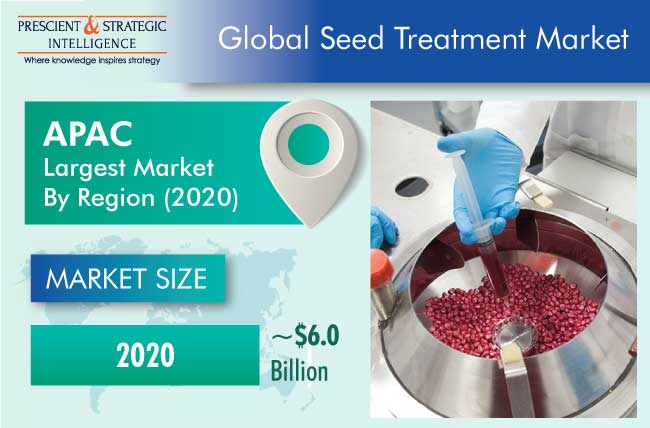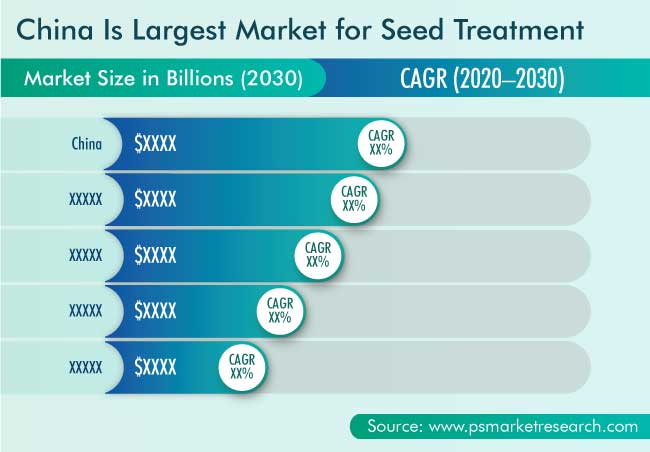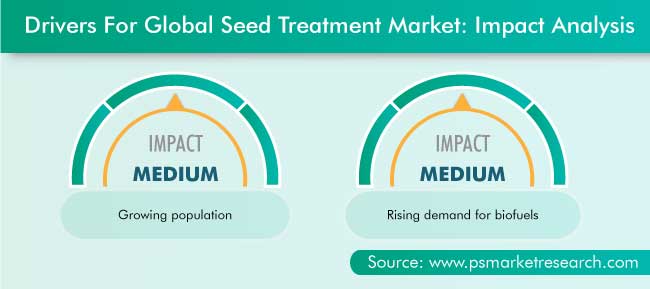Report Code: 11854 | Available Format: PDF
Seed Treatment Market Research Report: By Product Type (Chemical, Biological), Crop Type (Cereals & Grains, Oilseeds, Fruits & Vegetables), Application Method (Dressing, Coating, Pelleting), Application Time (Pre-Treatment, Farm Treatment) - Global Industry Analysis and Growth Forecast to 2030
- Report Code: 11854
- Available Format: PDF
- Report Description
- Table of Contents
- Market Segmentation
- Request Free Sample
Market Overview
The market for seed treatment products generated revenue of ~$6.0 billion in 2020, and it is expected to show significant growth during the forecast period (2021–2030). The major factors responsible for the growth of the market are the various initiatives taken by government and private organizations to improve the crop yield, rising usage of technologically advanced seed treatment solutions in order to enhance the seed quality, and increasing demand for basic grains and vegetables to feed the large population.
The impact of the COVID-19 pandemic on the global seed treatment market has been minimal due to the fact that all types of agricultural activities were exempted from the lockdowns in order to fulfill the basic needs of the large population. Agrochemical companies gained double-digit profits in 2020 compared to the previous year owing to farmers' panic buying.

Due to Improved Germination of Seeds, Chemical Category Dominated Industry
The chemical category accounted for the larger volume and revenue shares in the seed treatment market in the historical period (2015–2020), based on product type. This can be attributed to the ability of chemical seed treatment to improve the process of germination and maintain their health. Moreover, seed treatment chemicals provide a stronger repelling ability against insects, pests, and microorganisms compared to biological seed treatment products.
Rising Demand for Cereals & Grains Leads to their Market Domination
Cereals & grains held the largest share in the market for seed treatment products, both in terms of volume and value, in 2020, based on crop type. This can be attributed to the high-volume production of grains and cereals, such as barley, wheat, rice, corn, ragi, and sorghum, due to their rising consumption and increasing per capita income.
Dressing Category Held Major Share in Industry because of High-Volume Usage of Dry Formulation
The dressing category accounted for the largest volume and revenue shares in the seed treatment market over the past few years, based on application method. owing This was mainly because dressings can be used as dry formulations, wet treated with a slurry, and applied as a liquid formulation.
Pre-Treatment Seeds held Dominating Shares due to their Increasing Adoption
The pre-treatment category held the major share in the seed treatment market, both in terms of volume and revenue share, in 2020, based on application time. This can be primarily attributed to the increasing adoption by manufacturers to protect the seeds from seed-borne and soil-borne diseases in the primary stage of their growth.
Due to High-Volume Production of Crops, Asia-Pacific (APAC) Region held Dominating Share
APAC region was the largest market for seed treatment products in 2020, and it would retain its position during the forecast period. This will primarily be due to the high-volume production of crops in India, South Korea, Vietnam, China, and Australia. Further, these countries are applying more seed protection products to avoid crop damage.

Technological Advancements in Seed Coating Delivery Systems is a Major Trend
Due to the technological advancement in seed coating delivery systems, there is a significant shift from earlier coating systems. Earlier, copper sulphate was used to treat seeds by immersing the seeds in seawater containing three different copper sulphate concentrations, but now the heap or barn method, in which a small amount of a liquid is sprinkled over the seeds, is being used. Later, due to the inefficiency of the heap or barn method, it was eventually superseded by pelleting using wheat flour or other substances, which results in improved germination. Further, seed priming is also a physiological innovation for influencing seedling development by boosting pre-germination metabolic processes. Thus, modern ways of seed treatment are an important trend.

Growing Agriculture Sector Driving Market
According to the United Nations (UN), the current global population is around 7.7 billion, and it is expected to reach 8.9 billion by 2030. Due to the rising population, the demand for cereals, for both food and animal feed, is rising. As a result, the demand for seed treatment products would rise, as good-quality seeds are the basic requirement for the production of crops. Hence, the need to protect seedlings and young plants from diseases is propelling the seed treatment market growth, especially since agricultural production is itself booming.
Increasing Demand for Biofuels to Boost Sales of Seed Treatment Products
Due to the increasing demand for biofuels owing to the rising environmental concerns and initiatives taken by government and many private organizations, the demand for seed treatment products would show substantial growth. For the production of various biofuels, a variety of plants are used. For instance, bioethanol is produced by the fermentation of the sugar derived from starchy crops, such as sugarcane. In order to produce good-quality biofuels, the seeds of the plants from which the oil or sugar is to be extracted should be of a good quality, which would result in the seed treatment market growth.
| Report Attribute | Details |
Historical Years |
2015-2020 |
Forecast Years |
2021-2030 |
Base Year (2020) Market Size |
~$6.0 Billion |
Report Coverage |
Market Trends, Drivers, and Restraints, Revenue Estimation and Forecast, Segmentation Analysis, Regional and Country Breakdown, Impact of COVID-19, Companies’ Strategic Developments, Market Share Analysis, Company Profiling |
Market Size by Segments |
By Product Type, by Crop Type, By Application Method, By Application Time, By Region |
Market Size of Geographies |
U.S., Canada, Germany, France, Italy, U.K., Spain, Japan, China, India, Australia, South Korea, Brazil, Mexico, Saudi Arabia, South Africa |
Secondary Sources and References (Partial List) |
Arkansas Crop Protection Association, Bangladesh Crop Protection Association, Biopesticide Industry Alliance, Canadian Association of Agri-Retailers, Canadian Horticultural Council, Crop Science Society of America, European Crop Protection Association, Federation of Seed Industry of India, International Association for the Plant Protection Sciences, International Plant Protection Convention, National Seed Association of India, China Crop Protection Industry Association, Texas Plant Protection Association, American Seed Trade Association |
Explore more about this report - Request free sample
Product Launches is a Major Strategic Measure taken by Players to Gain Significant Position
Some of the major players operating in the seed treatment industry are BASF SE, Bayer AG, Novozymes A/S, Syngenta AG, Corteva Inc., FMC Corporation, Adama Ltd., Croda International Plc, UPL Ltd., Nufarm Limited, Eastman Chemical Company, Germains Seed Technology, Globachem N.V., Valent USA Corporation, and Verdesian Life Sciences LLC.
- In July 2020, Advanced Biological Marketing Inc. launched a biological seed treatment product, which is a metabolite. It has a low application rate, of 0.1 fluid ounces per unit of seed. It can result in yield gains of up to 11 bushels per acre.
- In March 2020, Corteva Inc. launched a non-neonicotinoid-based seed treatment product, named Lumivia CPL, for protecting the seeds of cereals, peas, and lentils from pests.
Key Players in Seed Treatment Market Include:
-
BASF SE
-
Bayer AG
-
Novozymes A/S
-
Syngenta AG
-
Corteva Inc.
-
FMC Corporation
-
Adama Ltd.
-
Croda International Plc
-
Nufarm Limited
-
Eastman Chemical Company
Market Size Breakdown by Segments
The seed treatment market report offers comprehensive market segmentation analysis along with market estimation for the period 2015-2030.
Based on Product Type
- Chemical
- Biological
Based on Crop Type
- Cereals & Grains
- Corn
- Wheat
- Rice
- Oilseeds
- Soybean
- Cotton
- Canola
- Sunflower
- Fruits & Vegetables
- Solanaceae
- Cucurbits
- Brassicas
- Leafy vegetables
- Root & bulb vegetables
Based on Application Method
- Dressing
- Coating
- Pelleting
Based on Application Time
- Pre-Treatment
- Farm Treatment
Geographical Analysis
- North America
- U.S.
- Canada
- Europe
- Germany
- France
- U.K.
- Italy
- Spain
- Asia-Pacific (APAC)
- Japan
- China
- India
- Australia
- South Korea
- Latin America (LATAM)
- Brazil
- Mexico
- Middle East and Africa (MEA)
- Saudi Arabia
- South Africa
The 2020 revenue of the market for seed treatment products was about $6.0 billion.
The seed treatment industry witnesses the higher sales of chemical products.
APAC dominates the market for seed treatment products because of its huge population and growing agricultural sector.
Advancements in seed coating delivery methods are trending in the seed treatment industry.
The competition in the market for seed treatment products is currently influenced by product launches.
Want a report tailored exactly to your business strategy?
Request CustomizationWant an insight-rich discussion with the report author?
Speak to AnalystOur dedication to providing the most-accurate market information has earned us verification by Dun & Bradstreet (D&B). We strive for quality checking of the highest level to enable data-driven decision making for you
Our insights into the minutest levels of the markets, including the latest trends and competitive landscape, give you all the answers you need to take your business to new heights
With 24/7 research support, we ensure that the wheels of your business never stop turning. Don’t let time stand in your way. Get all your queries answered with a simple phone call or email, as and when required
We take a cautious approach to protecting your personal and confidential information. Trust is the strongest bond that connects us and our clients, and trust we build by complying with all international and domestic data protection and privacy laws